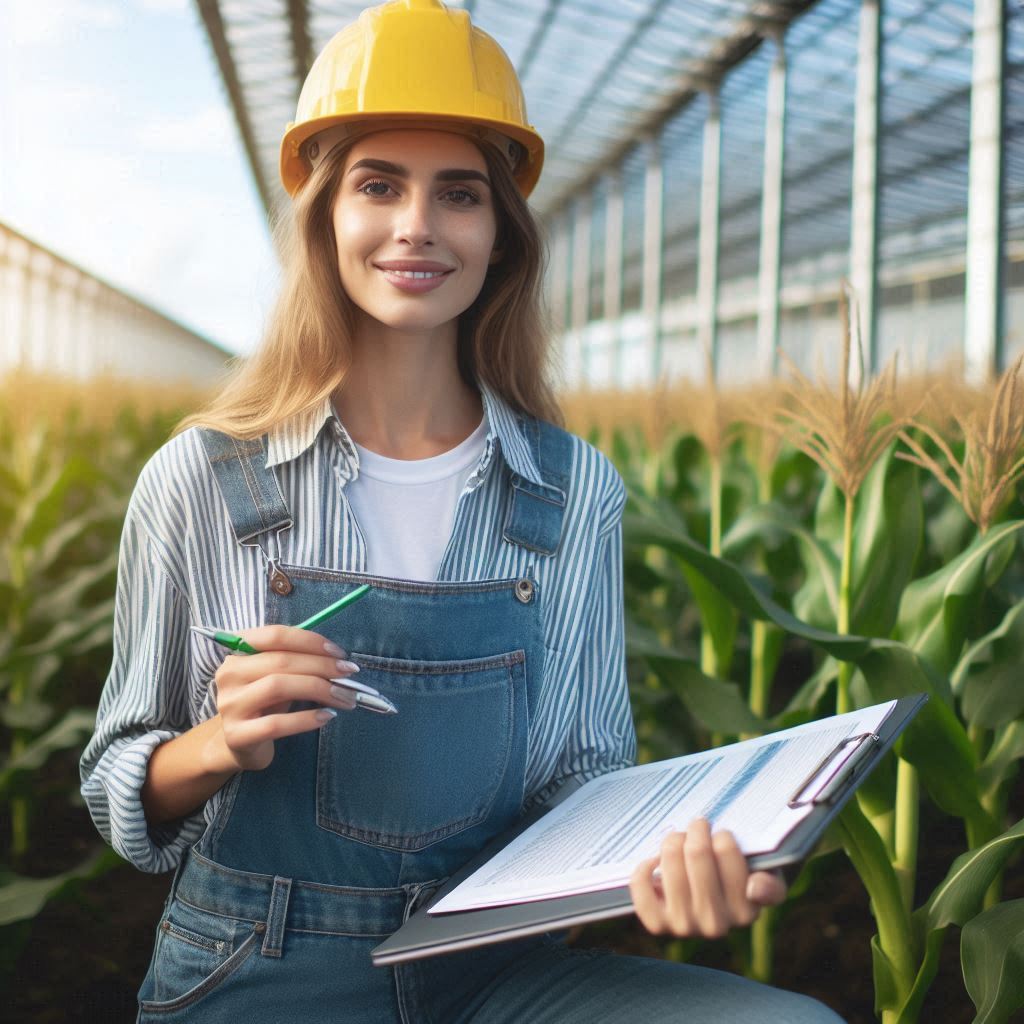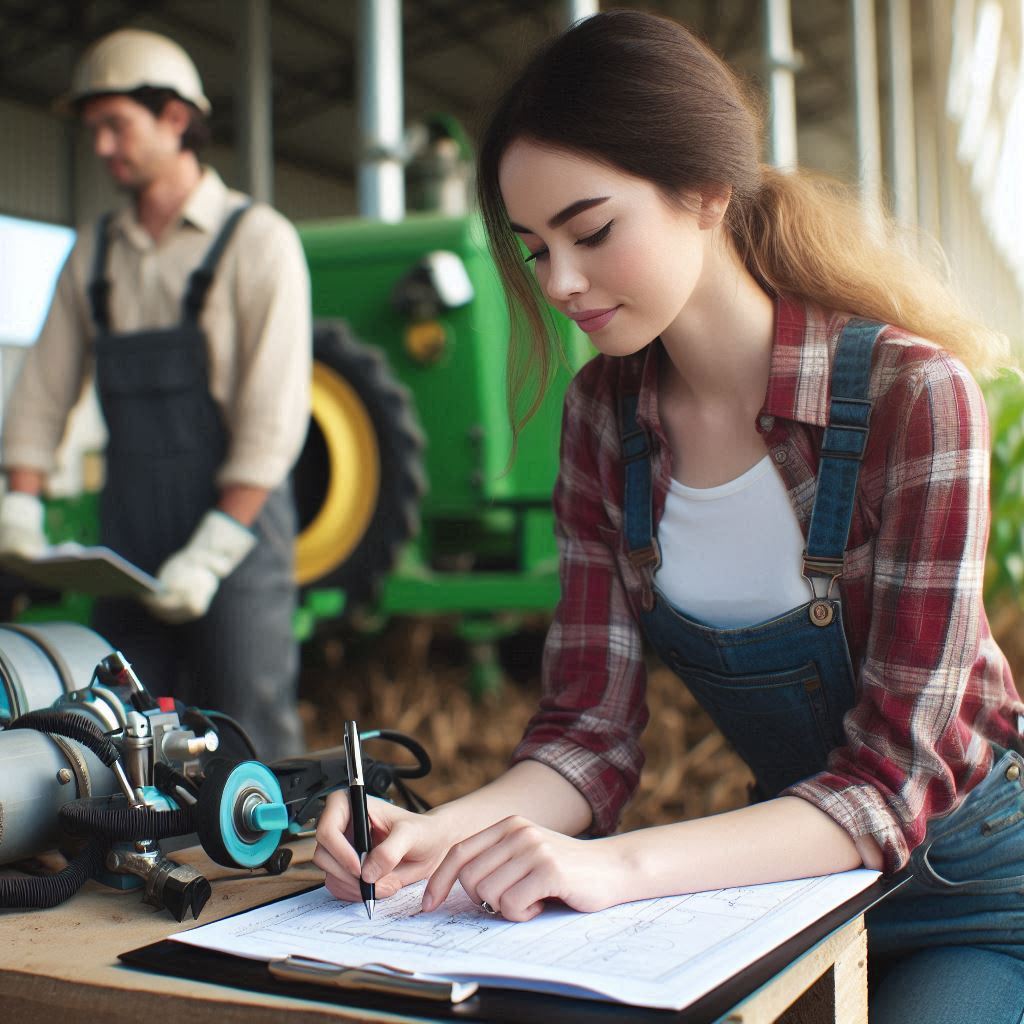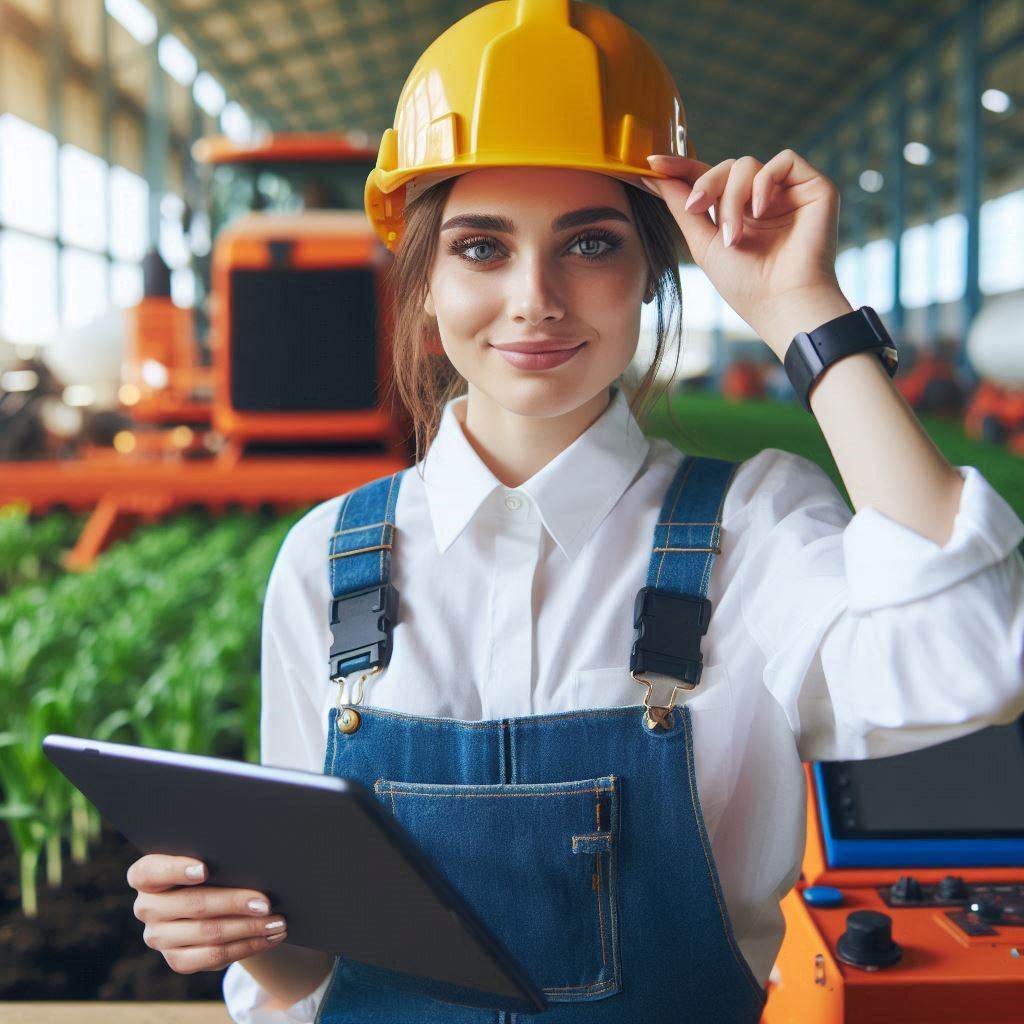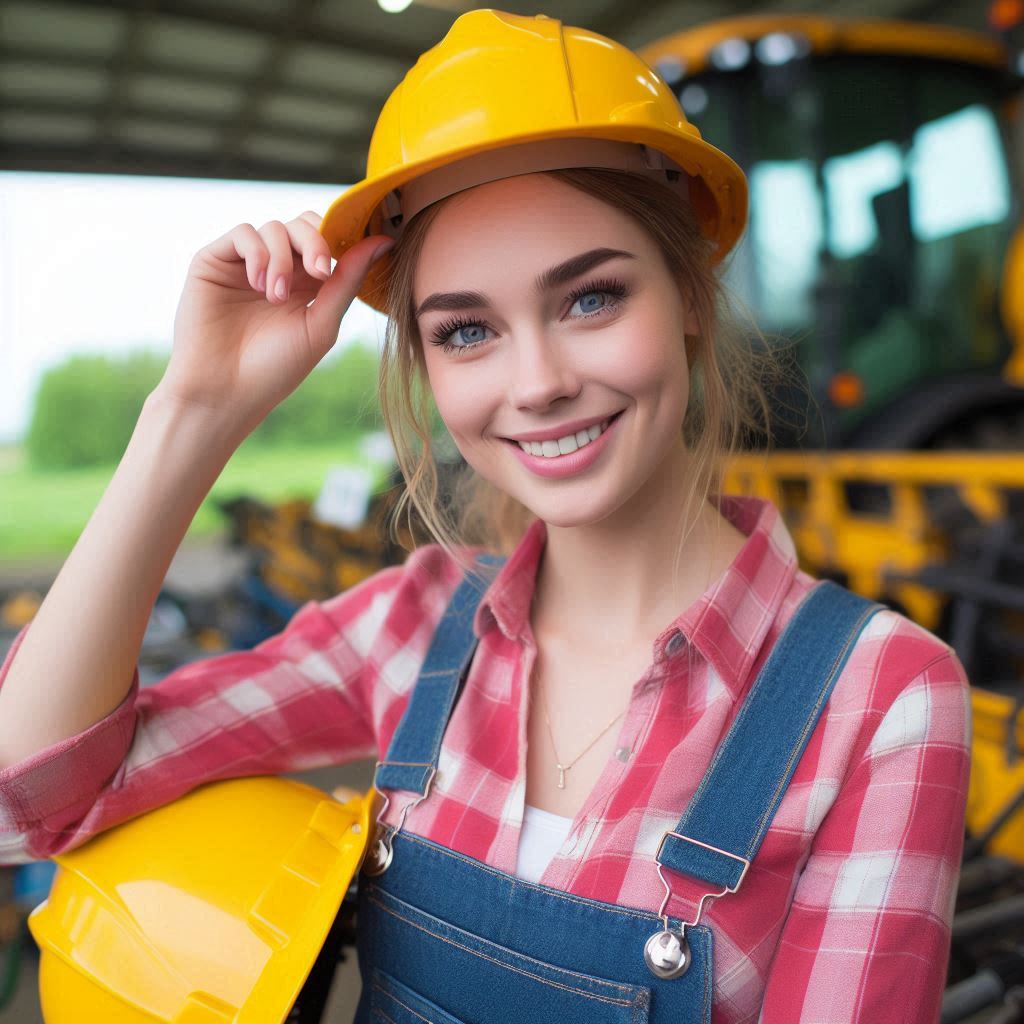Introduction
Agricultural engineers play a crucial role in advancing farming practices through innovative technology.
They focus on designing and improving systems to enhance agricultural efficiency and productivity.
One of the most impactful technologies recently adopted is drone technology.
Drones, or unmanned aerial vehicles (UAVs), offer a range of benefits for modern agriculture.
These versatile machines allow agricultural engineers to monitor large fields quickly and efficiently.
Drones equipped with high-resolution cameras and sensors provide detailed aerial images of crops.
This capability is invaluable for assessing crop health and detecting potential issues such as diseases or nutrient deficiencies.
Drones also contribute significantly to precision agriculture.
Engineers use them to analyze soil conditions and optimize irrigation strategies.
By collecting and analyzing data from drone surveys, they can make informed decisions about water usage, reducing waste and improving crop yields.
Furthermore, drones assist in monitoring livestock and managing large farming operations.
Engineers can use drones to track animal movements and ensure their well-being.
This approach helps streamline farm management and enhances overall efficiency.
Overview of Agricultural Engineering
Definition of Agricultural Engineering
Agricultural engineering combines principles of engineering, technology, and biology to improve farming practices.
It focuses on designing systems and tools that enhance agricultural productivity and sustainability.
Agricultural engineers apply their expertise to solve problems related to farming equipment, soil management, irrigation, and more.
Their goal is to develop innovative solutions that boost efficiency and address the challenges of modern agriculture.
Role of Agricultural Engineers in Improving Agricultural Practices
Agricultural engineers play a vital role in transforming farming practices through technological advancements.
They are responsible for developing and implementing systems that optimize agricultural operations.
One significant advancement is the use of drones in farming.
Drones, or unmanned aerial vehicles (UAVs), provide valuable data that enhances farming practices.
Agricultural engineers utilize drones to monitor crop health, manage irrigation, and analyze soil conditions.
By incorporating drones into their work, engineers can gather high-resolution aerial imagery.
This imagery helps them assess crop health and detect issues early.
Engineers use this data to make informed decisions about fertilization and pest control, reducing waste and improving yields.
Additionally, drones assist in precision agriculture by allowing for more accurate and targeted application of inputs such as water and nutrients.
Importance of Technological Advancements in the Field
Technological advancements are crucial for the evolution of agricultural engineering.
Drones represent a significant leap forward, offering real-time insights and detailed data collection.
They enhance the ability of agricultural engineers to address complex challenges and optimize farming practices.
Advanced technologies like drones enable engineers to gather comprehensive information on crop conditions and soil health.
This data is essential for making data-driven decisions that improve productivity and sustainability.
The integration of drones and other technologies into agriculture reflects a broader trend toward precision farming and resource efficiency.
As technology continues to advance, agricultural engineers will have more tools at their disposal.
These tools will allow them to tackle emerging challenges and drive innovation in the field.
Embracing technological advancements is key to ensuring that agricultural practices remain effective and sustainable in the face of evolving demands and environmental changes.
Basically, agricultural engineers are pivotal in advancing farming practices through technology.
Drones are a prime example of how technological innovations can enhance efficiency and decision-making.
By leveraging these advancements, engineers contribute to more productive and sustainable agriculture, ensuring the field continues to evolve and improve.
Introduction to Drone Technology
Benefits of Using Drones in Farming
- Precision Agriculture: Drones equipped with sensors and cameras can capture high-resolution images of crops, soil, and fields. This data can be used to assess crop health, identify issues like pest infestation or nutrient deficiencies, and optimize irrigation and fertilization practices.
- Time and Cost Efficiency: Drones can cover large areas of farmland in a fraction of the time it would take humans or traditional machinery. This not only saves time but also reduces labor costs and fuel consumption.
- Remote Monitoring: Farmers can monitor their fields in real-time from anywhere through live video feeds and data collected by drones. This allows for quick decision-making and timely interventions in case of crop diseases, pest outbreaks, or adverse weather conditions.
- Sustainability: By precisely targeting areas that need treatment, drones help reduce the use of chemicals, fertilizers, and water, thus minimizing environmental impact and promoting sustainable farming practices.
Types of Drones Used in Agriculture
- Fixed-Wing Drones: Fixed-wing drones resemble traditional airplanes and are ideal for covering large expanses of land in a single flight. They have longer flight times and can carry heavier payloads, making them suitable for mapping and surveying tasks.
- Multi-Rotor Drones: Multi-rotor drones, such as quadcopters and hexacopters, are popular for their maneuverability and stability. They can hover in place, fly at low altitudes, and capture detailed images, making them suitable for crop scouting and monitoring.
- Hybrid Drones: Hybrid drones combine the benefits of fixed-wing and multi-rotor drones. They can take off and land vertically like multi-rotors and transition to fixed-wing flight for longer range and endurance, making them versatile for various agricultural applications.
Applications of Drones in Farming
- Crop Monitoring: Drones equipped with cameras and sensors can capture detailed images of crops from above. This data can be analyzed to detect crop health issues, assess plant density, and monitor growth stages.
- Field Mapping: Drones can create high-resolution maps of farmland, including elevation, soil moisture levels, and crop distribution. This information helps farmers plan irrigation, drainage, planting, and harvesting activities more effectively.
- Pest Control: Drones can be fitted with spraying systems to apply pesticides, herbicides, or fertilizers precisely where needed. This targeted approach reduces chemical usage, minimizes drift, and ensures effective pest management.
- Livestock Management: Drones are used to monitor livestock, fence lines, and water sources in large grazing areas. They can track animal movements, identify potential predators, and assess herd health, enhancing overall farm management.
- Crop Spraying: Drones equipped with spraying equipment can cover fields with pesticides, herbicides, or fertilizers quickly and efficiently. They can access hard-to-reach areas, reduce soil compaction, and minimize chemical exposure to operators.
Challenges and Future Outlook
- Regulatory Hurdles: The use of drones in farming is subject to regulations regarding flight restrictions, privacy concerns, and licensing requirements. Compliance with these rules is critical to ensure safe and legal operations.
- Technical Limitations: Drones face challenges such as limited battery life, payload capacity, and flight range. Continued research and development are essential to improve drone capabilities and make them more reliable and cost-effective for agricultural use.
- Data Management: The vast amount of data collected by drones needs to be processed, analyzed, and integrated with other farm management systems. Farmers must have the necessary tools and expertise to interpret this data effectively and derive actionable insights.
- Integration with Other Technologies: Drones are increasingly being integrated with artificial intelligence, machine learning, and Internet of Things (IoT) devices to enhance their capabilities. This integration allows for more autonomous, efficient, and data-driven farming practices.
- Future Outlook: The future of drones in agriculture looks promising, with continued advancements in technology and increased adoption by farmers worldwide. As drones become more sophisticated, affordable, and user-friendly, they are expected to play a significant role in shaping the future of farming and promoting sustainable food production.
Overall, the use of drones in farming offers numerous benefits, including precision agriculture, time and cost efficiency, remote monitoring, and sustainability.
By leveraging drone technology, farmers can improve crop yields, reduce inputs, and make informed decisions to optimize farm operations.
Despite some challenges, the future of drones in agriculture is bright, with the potential to transform the way we grow and harvest crops.
Benefits of Using Drones in Farming
Improved Crop Monitoring and Management
Drones provide farmers with a bird’s eye view of their fields, allowing for quick and efficient monitoring of crop health.
By capturing high-resolution images and data, drones can identify early signs of disease, nutrient deficiencies, or pest infestations.
This timely information enables farmers to take proactive measures to address any issues before they escalate, ultimately leading to healthier crops and higher yields.
Enhanced Precision Agriculture Techniques
The use of drones in farming has revolutionized precision agriculture, allowing for targeted interventions such as variable rate application of fertilizers, pesticides, and water.
By analyzing data collected by drones, farmers can create detailed maps of their fields, identifying areas that require specific inputs.
This targeted approach not only maximizes resource efficiency but also minimizes waste, leading to sustainable farming practices.
Cost and Environmental Impact Reduction
One of the key benefits of using drones in farming is the significant reduction in labor costs.
Instead of manually walking through fields to assess crop conditions, farmers can deploy drones to collect data in a fraction of the time.
This not only saves labor expenses but also reduces the risk of human error, ensuring more accurate and reliable information for decision-making.
Furthermore, drones contribute to environmental sustainability by helping farmers minimize their use of inputs such as fertilizers and pesticides.
By precisely targeting areas that require treatment, farmers can apply these substances only where necessary, reducing the overall environmental impact.
This targeted approach not only benefits the environment but also improves the quality of crops by reducing chemical residues.
Generally, the benefits of using drones in farming are numerous and far-reaching.
From improved crop monitoring and management to enhanced precision agriculture techniques and cost reduction, drones have revolutionized the way farmers approach agriculture.
By adopting drone technology, farmers can increase efficiency, reduce costs, and minimize their environmental impact, ultimately leading to more sustainable and productive farming practices.
Read: Comparison: Architecture Styles across American Regions.
Specific Applications of Drones in Farming
Agricultural engineers are leveraging drones to enhance various aspects of farming.
These unmanned aerial vehicles (UAVs) provide critical insights that transform traditional agricultural practices.
Drones offer several innovative applications, such as aerial surveillance, mapping, and pest management, each contributing significantly to modern farming efficiency.
Aerial Surveillance for Crop Health Assessment
Drones equipped with high-resolution cameras and multispectral sensors allow agricultural engineers to conduct aerial surveillance of crops.
These drones capture detailed images and data, providing a bird‘s-eye view of crop conditions.
Engineers use this data to assess plant health, identify signs of stress, and detect issues such as nutrient deficiencies or diseases.
Regular aerial surveys enable early intervention, which helps in maintaining crop health and optimizing yields.
The ability to monitor large areas quickly and accurately ensures that farmers can address problems before they escalate.
Mapping of Fields for Irrigation and Fertilization Planning
Drones play a crucial role in mapping fields for efficient irrigation and fertilization planning.
Equipped with advanced imaging technology, drones create detailed maps of farm fields, including variations in soil moisture and topography.
Agricultural engineers analyze these maps to design and implement precise irrigation systems.
This data helps in applying water where it is needed most, reducing waste and ensuring that crops receive adequate hydration.
Similarly, drones help in planning fertilization by identifying nutrient-deficient areas.
This targeted approach minimizes the use of fertilizers, reduces environmental impact, and improves crop productivity.
Pest Detection and Management Using Thermal Imaging
Thermal imaging technology on drones provides a powerful tool for pest detection and management.
Drones equipped with thermal cameras can detect temperature variations caused by pest infestations.
These variations often appear as abnormal heat patterns, allowing engineers to identify areas where pests are active.
Early detection of pest problems enables timely and targeted treatments, reducing the need for broad-spectrum pesticide applications.
This approach minimizes chemical use, lowers costs, and helps protect beneficial insects and the environment.
Benefits of Using Drones in Farming
The integration of drones into farming practices offers numerous advantages.
Aerial surveillance improves crop health monitoring and allows for prompt action against issues.
Field mapping enhances the efficiency of irrigation and fertilization, leading to better resource management.
Pest detection using thermal imaging helps manage infestations with precision, reducing environmental impact.
Transform Your Career Today
Unlock a personalized career strategy that drives real results. Get tailored advice and a roadmap designed just for you.
Start NowIn fact, agricultural engineers utilize drones to revolutionize farming practices.
Aerial surveillance provides insights into crop health, field mapping optimizes resource use, and thermal imaging aids in pest management.
These advancements contribute to more efficient, sustainable, and productive agriculture.
As drone technology continues to evolve, its role in farming is expected to expand, offering even more innovative solutions to agricultural challenges.
Agricultural engineers continue to innovate and develop new uses for drones in farming, making them an essential tool for the future of agriculture.
Read: 5 Essential Software Tools Every US Architect Uses.
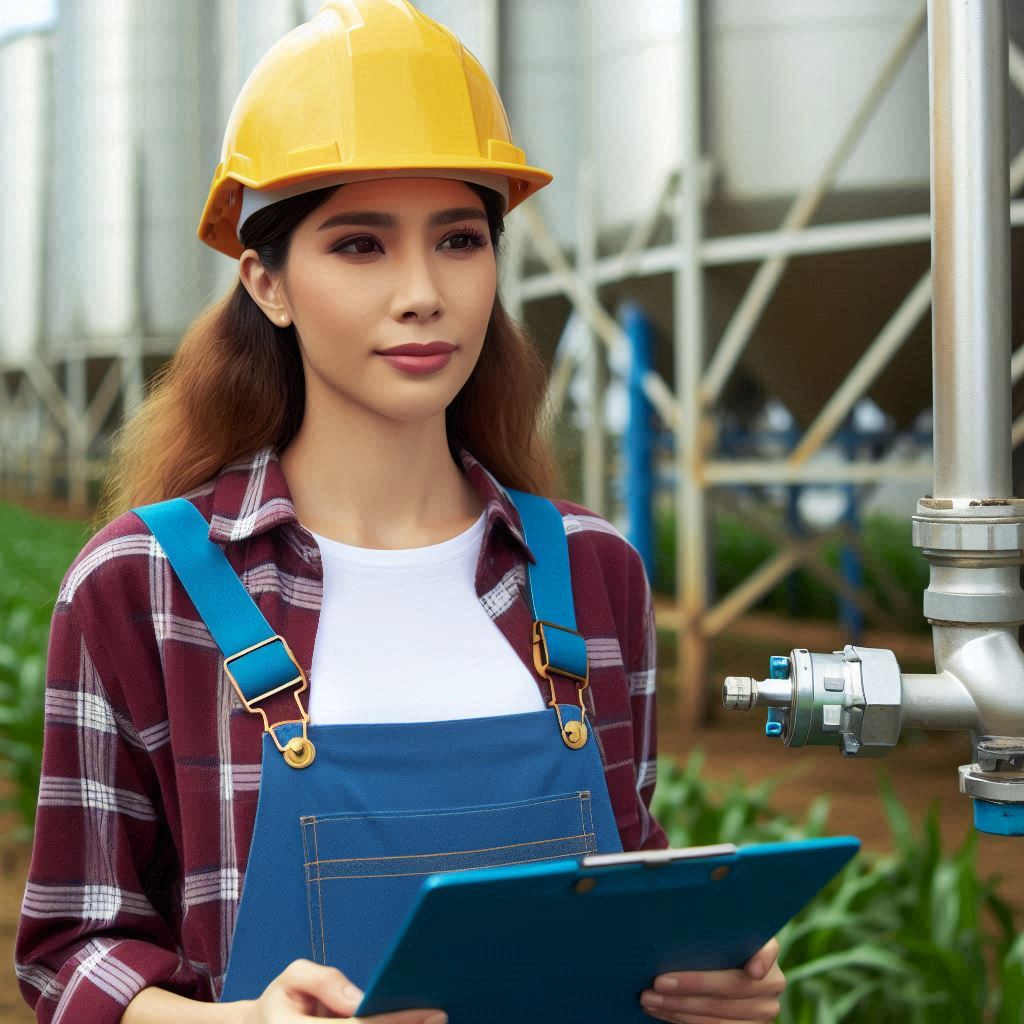
Integration of Drones with Other Agricultural Technologies
When it comes to modern farming practices, the integration of drones with other agricultural technologies has revolutionized the way farmers work and manage their crops.
Use of Drones in Coordination with GPS Technology
Drones equipped with GPS technology have become valuable tools for agricultural engineers.
By integrating drones with GPS systems, farmers are able to accurately map out their fields, identify areas of concern, and create efficient flight paths for the drones to follow.
GPS technology allows drones to navigate through the fields with precision, collecting data on crop health, soil conditions, and other important factors.
This data is then used by farmers to make informed decisions about irrigation, fertilization, and pest control.
Data Collection and Analysis for Decision-Making
One of the key benefits of using drones in farming is their ability to collect vast amounts of data quickly and efficiently.
Drones are equipped with cameras, sensors, and other technology that allow them to gather information about crop health, growth patterns, and potential issues.
Once the data is collected, it can be analyzed using advanced software programs to provide farmers with valuable insights.
The data can help farmers identify areas that require attention, track changes in crop health over time, and make informed decisions about crop management.
Collaboration with Agricultural Machinery for Automated Processes
Another way drones are being integrated into farming is through collaboration with agricultural machinery.
Drones can be programmed to work in tandem with tractors, planters, and other equipment to automate tasks such as crop monitoring, seeding, and spraying.
By working together, drones and agricultural machinery can streamline processes, reduce labor costs, and increase efficiency.
For example, drones can fly over fields to collect data, which is then used to adjust the settings on machinery for precise seeding or spraying.
This level of automation helps farmers save time and resources while improving crop yields.
In essence, the integration of drones with other agricultural technologies is transforming the way farming is done.
By using drones in coordination with GPS technology, gathering and analyzing data for decision-making, and collaborating with agricultural machinery for automated processes, farmers are able to optimize their operations and improve crop yields.
As technology continues to advance, drones will likely become even more essential tools for modern agriculture.
Read: US Tech Hubs Beyond Silicon Valley: Emerging Cities
Challenges and Limitations of Using Drones in Farming
While the use of drones in farming has numerous benefits, there are also challenges and limitations that agricultural engineers need to consider.
Regulatory restrictions on drone use in agriculture
One major challenge that agricultural engineers face when using drones in farming is regulatory restrictions.
Many countries have strict regulations regarding the use of drones in agricultural practices.
This includes restrictions on where drones can fly, how high they can fly, and who can operate them.
Agricultural engineers must stay up to date with these regulations and ensure that they are in compliance when using drones on farms.
Initial investment and training requirements
Another challenge of using drones in farming is the initial investment and training requirements. Drones can be expensive to purchase, especially those with advanced technologies and capabilities.
In addition to the cost of the drones themselves, agricultural engineers must also invest in training programs to learn how to effectively operate and maintain the drones.
This requires both time and financial resources, which can be a barrier for some farmers.
Limitations of drone battery life and payload capacity
One of the limitations of using drones in farming is the drone‘s battery life and payload capacity.
Most drones have a limited battery life, which can restrict the amount of time they can spend in the air collecting data or spraying crops.
Additionally, drones have a limited payload capacity, which can restrict the amount of equipment or materials they can carry.
Agricultural engineers must carefully plan their drone usage to ensure that these limitations do not hinder their farming operations.
Essentially, while drones offer many benefits for agricultural engineers, there are also challenges and limitations that must be considered.
By understanding and addressing these challenges, agricultural engineers can effectively integrate drones into their farming practices to improve efficiency and productivity.
Read: Top Cities for Electrical Engineering Jobs in America
Discover More: Best Practices for Database Performance Tuning
Future Prospects of Drone Technology in Agriculture
Continued Advancements in Drone Technology for Farming Applications
Agricultural engineers are harnessing the power of drones to transform farming practices.
Drones have become essential tools in modern agriculture, offering precise data collection and analysis.
Continued advancements in drone technology enhance their capabilities, making them more efficient and effective for farming applications.
Newer models feature improved sensors, higher resolution cameras, and longer flight times.
These advancements allow drones to cover larger areas and capture more detailed images.
Enhanced GPS and navigation systems ensure accurate flight paths and data collection.
Additionally, advancements in battery life and energy efficiency extend operational periods, enabling more comprehensive data gathering.
As drone technology evolves, it becomes increasingly integrated into farming practices, providing valuable insights for better crop management and resource optimization.
Integration of Artificial Intelligence and Machine Learning in Drone-Based Systems
Artificial intelligence (AI) and machine learning (ML) are revolutionizing drone-based systems in agriculture.
AI algorithms analyze data collected by drones to detect crop health issues, pest infestations, and nutrient deficiencies.
Machine learning models improve the accuracy of these detections by continuously learning from new data.
Drones equipped with AI can identify patterns and anomalies in crop images that may be missed by the human eye.
For example, AI can predict crop yields and recommend precise interventions to optimize growth.
ML algorithms process vast amounts of data quickly, providing actionable insights in real time.
The integration of AI and ML enhances the decision-making process for agricultural engineers, enabling more precise and timely actions to improve crop productivity and reduce resource use.
Transform Your Career Today
Unlock a personalized career strategy that drives real results. Get tailored advice and a roadmap designed just for you.
Start NowPotential for Drones to Revolutionize Farming Practices Globally
Drones have the potential to revolutionize farming practices on a global scale.
Their ability to collect and analyze data from the air provides farmers with unprecedented insights into their crops.
This technology allows for more precise and targeted applications of water, fertilizers, and pesticides.
By optimizing resource use, drones contribute to more sustainable farming practices.
Additionally, drones can monitor large areas of farmland quickly, reducing the time and labor required for traditional methods.
The use of drones also enables farmers to detect issues early and address them promptly, minimizing crop loss and increasing yields.
As drone technology continues to advance, its adoption in agriculture is expected to grow, driving innovation and efficiency in farming practices worldwide.
Ultimately, agricultural engineers are leveraging advancements in drone technology to enhance farming practices.
The integration of AI and ML into drone systems further amplifies their impact, offering precise data analysis and actionable insights.
As drones become more sophisticated, their potential to revolutionize agriculture globally becomes increasingly evident, paving the way for more efficient and sustainable farming practices.
Conclusion
Drones have become a game-changer in modern agriculture, offering numerous benefits while presenting some challenges.
Their ability to capture high-resolution aerial images provides farmers with precise data on crop health, soil conditions, and irrigation needs.
This technology allows for detailed monitoring of large areas, which traditional methods often cannot achieve as efficiently.
By using drones, agricultural engineers can conduct detailed analyses of crop growth patterns, detect pest infestations early, and assess the effectiveness of irrigation systems.
However, the adoption of drones in farming comes with its own set of challenges.
The initial cost of drone technology can be high, which may be a barrier for some farmers.
Additionally, operating drones requires specialized training and knowledge to maximize their potential.
Ensuring that farmers and agricultural engineers are properly trained to use this technology is crucial for its successful implementation.
Despite these challenges, the potential for drones to transform agricultural engineering practices is significant.
Drones offer real-time data collection and analysis, leading to more informed decision-making and improved resource management.
They enable precision agriculture by allowing engineers to tailor interventions based on detailed aerial data, which can enhance crop yields and reduce waste.
[E-Books for Sale]
The Big Book of 500 High-Paying Jobs in America: Unlock Your Earning Potential
$19.99 • 500 High-Paying Jobs • 330 pages
Explore 500 high-paying jobs in America and learn how to boost your career, earn more, and achieve success!
See All 500 High-Paying Jobs of this E-Book
1001 Professions Without a Degree: High-Paying American Jobs You Can Start Now
$19.99 • 1001 Professions Without a Degree • 174 pages
Discover 1001 high-paying jobs without a degree! Unlock career tips, skills, and success strategies for just $19.99!

